It Looks Cool, But Does 3D-Printed Food Taste Any Good?

A 3D printer at the new 3DS Culinary Lab. (Photo courtesy of Jackie Strause.)
The future is officially here.
On a Los Angeles street corner in the center of Hollywood, a culinary lab dedicated to 3D food printing has opened its doors.
Launched by 3DSystems, the leading 3D printing and manufacturing company, the digital kitchen is the first of its kind and aims to be a trendsetter. Designed to be an educational and collaborative environment, the open space beckons chefs, mixologists, and culinary innovators alike to come together to test, invent, and teach. But first, local press and guests got the opportunity to tour the facility — and eat some 3D-printed treats.

The lab is located near the corner of Melrose and Highland in Los Angeles, a stone’s throw from some of the world’s most creative chefs. (Photo: 3DSystems)
Two burning questions immediately came to mind: How exactly do you make 3D-printed food? And how does it taste?
“The easiest way to think about it is that a 3D printer takes a virtual 3D file from a computer and then builds that object really carefully, layer by layer, into a physical object,” says Kyle von Hasseln, who makes up half of the husband-and-wife team that serves as the lab’s creative directors. “Totally simple,” he adds.
While it might not sound “totally simple,” when you see the printers in action, you realize Kyle is kind of right.

Photo courtesy of Jackie Strause.
In the center of the lab, six humming ChefJetPro 3D printers are hard at work. Once an item is ready to be printed, it gets sent to one of the printers through the lab’s modeling software, where a designer and chef previously collaborated on how the food will look. Together, they also decide on which ingredients to use in the printer.
Finished products on display are multi-colored, eye-popping sugar confections that range from bite-sized morsels to a three-tiered wedding cake. “We can print with onion powder, wasabi powder, sugar, fruits and vegetables — really anything you can imagine,” Kyle explains. The color is achieved naturally, like in the case of the wasabi, or with food coloring that is added while the printer builds. “The printer can add food coloring to every pixel, or over the whole object and just build millions of beautiful colors on the surface.”
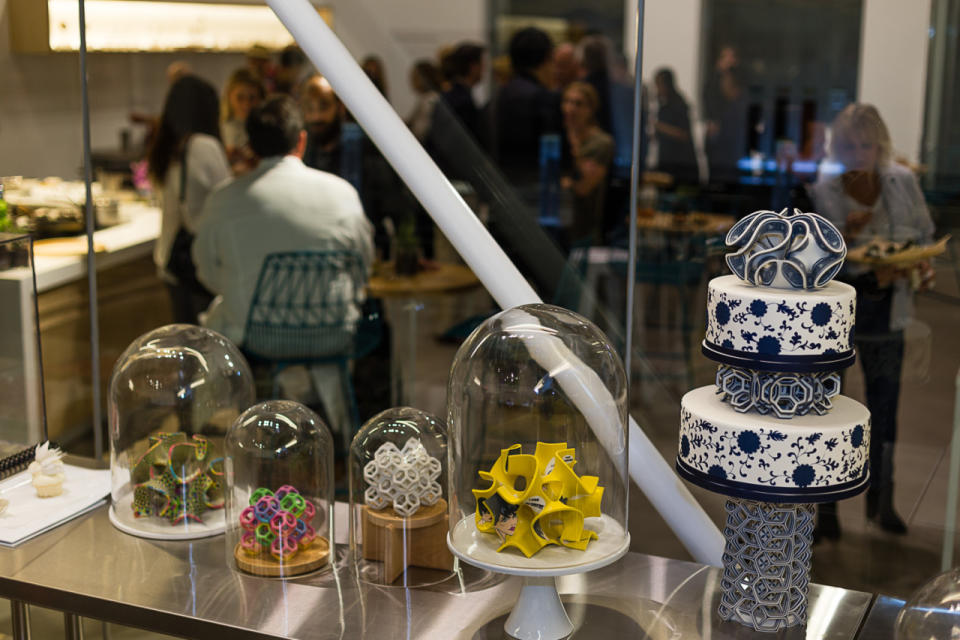
The ChefJet Pro can print about 100 small candies per hour, while larger cakes can take five to six hours. (Photo: 3DSystems)
Kyle compares the recipe-making process to making soup, except that it’s in powder form and volume is measured in teaspoons instead of cubic inches. “You can get shapes that are really hollow but volumatic, so there are less calories total. It’s really about what you put in it,” he says. You can even print natural foods with a farm-to-3D printer model: “You source dehydrated fruits and vegetables that are organic and from vendors that you trust, and then you grind it up, in a little coffee grinder or mill, and pop it right in the 3D printer.”
Sweets, being simple and pretty, were the most ideal place to start. “Desserts are this space where people are really used to designed objects,” says Kyle, who mentions the high-demand for stunning bridal cakes. But the more that they worked with professionals, the more experimenting and building they did on the savory side while playing with flavors like the wasabi, and salt, pepper, and mushroom — which leads us to the evening’s menu.
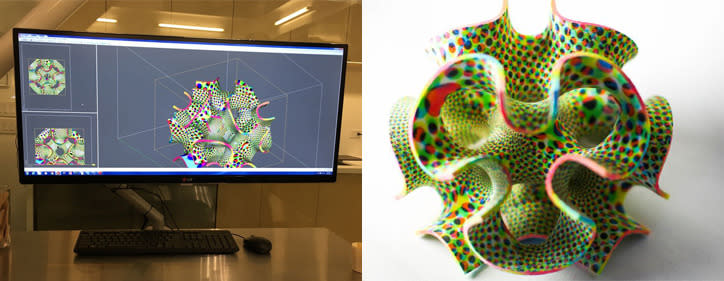
Before and after. (Photo: 3DSystems)
Behind the printing room, the night’s chefs and sous chefs prep their dishes in an open kitchen. Some of the world’s most creative chefs are experimenting with 3D printing, and the lab intends to gather as many of them as they can. Their opening night was no exception.
Chef Josiah Citrin of Santa Monica’s two-Michelin-starred Mélisse ladled out deconstructed French Onion soup made with a 3D-printed onion powder cube. Instead of the traditional crouton, which gets soggy in the broth, the cube slowly melted away its flavor so each spoonful was as tasty as the last.
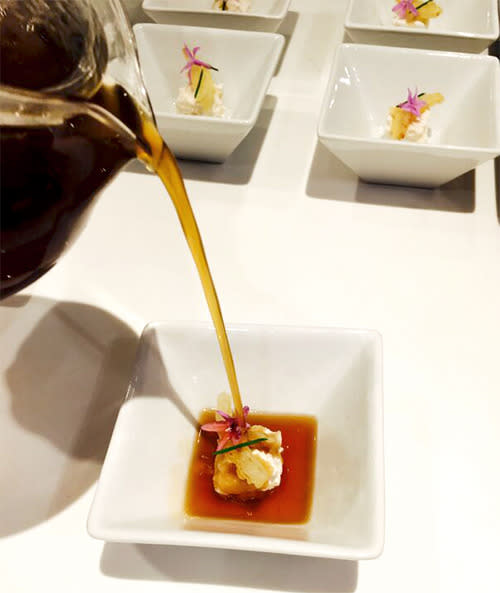
Photo courtesy of Jackie Strause.
His 3D-printed pumpkin and maple waffle, topped with bacon and a quail egg, was to be devoured in one bite. The flavors stayed distinct as the dish exploded in your mouth.

Photo courtesy of Jackie Strause.
Last season’s Top Chef winner Mei Lin printed a wasabi egg that she placed over a Wagyu steak tartare. Biting into the crunchy shell sent a warm and creamy center oozing onto the cool, chopped meat.
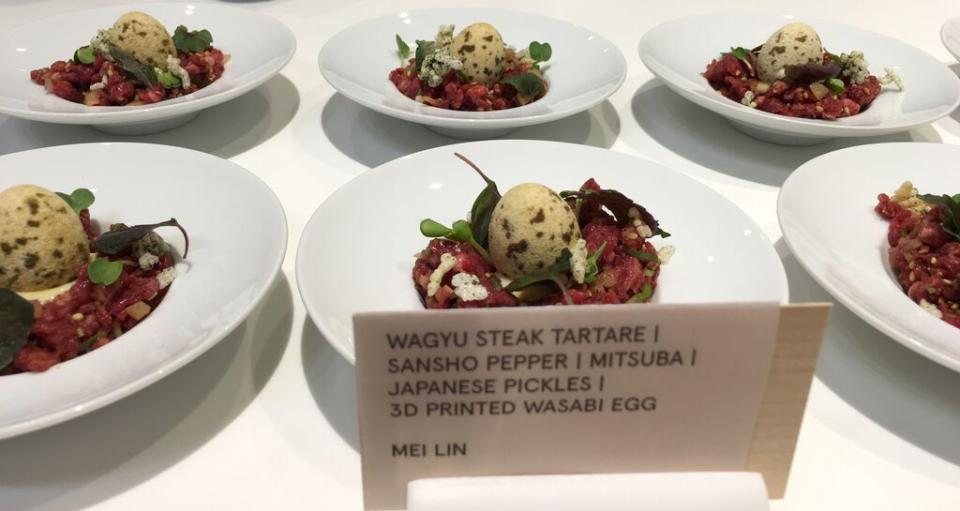
Photo courtesy of Jackie Strause.
For dessert, she instructed guests to break a 3D-printed flower over passion fruit curd and a toasted yogurt crumble. The crunchy fruit flower, almost too pretty to destroy, added another tasty layer to the inventive treat.
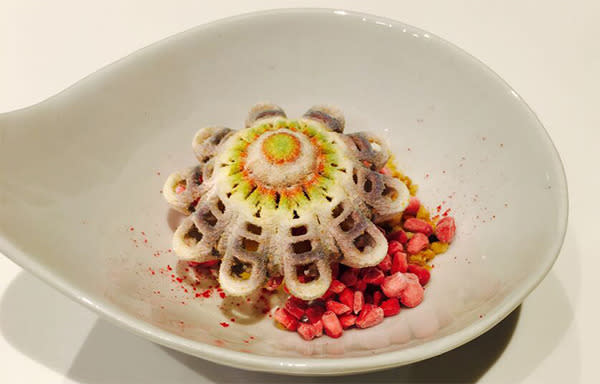
Photo courtesy of Jackie Strause.
To flavor the tequila- and gin-based cocktails, “Eat Your Drink” cocktail chef Matthew Biancaniello decorated glasses with a maple-flavored, candy-cap mushroom 3D-printed garnish and 3D-printed crystals of smoke salt, which disintegrated instantly and provided just the right amount.
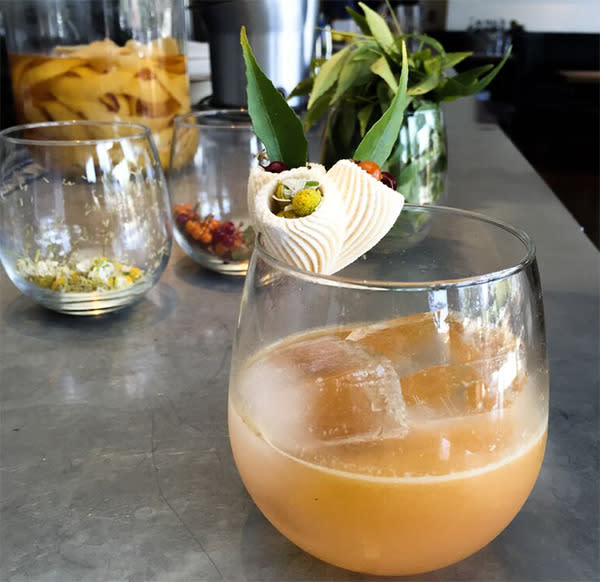
Photo: 3DSystems
To sum it up, 3D-printed food can taste sweet, savory, crunchy, salty, and downright delicious. The guests were pleasantly surprised, and the chefs were excited, truly like kids in a candy shop with their new toy.
“In the last couple of years, 3D printing has come into the public consciousness,” says Kyle. “Everybody knows about it and is willing to engage with the technology, and chefs are no exception. We get interest from chefs every day who have these really wild concepts that they want to try out and for the most part, are going to work.”
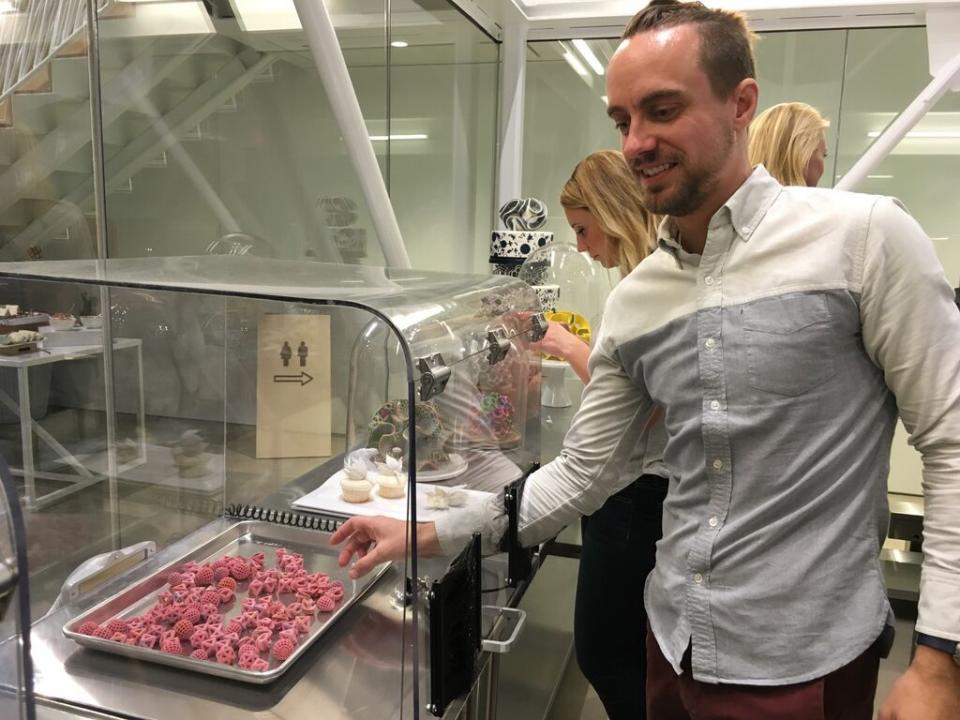
Kyle von Hasseln, pictured, and his wife Liz are the lab’s creative directors. (Photo courtesy of Jackie Strause.)
When that day comes, Kyle assures me that the printer is easy to use and that consumers will learn to operate it in their homes the same way they once learned how to use a simple microwave. Until then, get ready for 3D-printed elements to start showing up at restaurants.
“If you’re not sure, take a look at it on your plate,” says Kyle. “Smell it and look at it. It will look beautiful and smell amazing and the truth is, it’s made out of natural ingredients that your chef prepared for you especially for that evening, and that’s the culinary tradition in a nutshell already. There’s very little new here.”
Just endless possibilities. Like these 3D printed cookies, just in time for Christmas.

